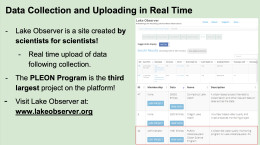Lacawac Sanctuary uses Lake Observer app for community-led monitoring on Lake Wallenpaupak

Staff from Lacawac Sanctuary Field Station and Environmental Education Center in Pennsylvania presented the results of their project “Algal Blooms Spark Community Led Monitoring on Lake Wallenpaupack” at an international symposium of the North American Lake Management Society (NALMS).
Lake Wallenpaupack is the third largest lake in Pennsylvania where there is rising concern and calls to Lacawac Sanctuary about algal blooms and cyanobacteria blooms. A 2019 study found detectable levels of cyanotoxins (cylindrospermopsin) in Lake Wallenpaupack samples.
As a GLEON site member, Lacawac Science Director Beth Norman reached out to another GLEON site with similar issues. A monitoring program was designed and adapted from the Lake Lillinonah CLEO Program in Connecticut. In 2019, a community-led monitoring program began on 41 sites throughout the lake using the Lake Observer mobile app. Cary Institute staff helped partners at Lake Wallenpaupack set-up the app for use in their project, which quickly became the third largest project on the platform.
At the NALMS symposium in Erie, PA, Alexandra Bros and Beth Norman presented how collected data was used to understand the relationships between chlorophyll concentrations, Secchi depth, and temperature and the variability of water quality measurements in the lake. In 2021, the region experienced extreme weather from hurricanes and in 2022, there was a 5-year drawdown, adding to the variation in measurements.
Lessons learned from the project:
- Volunteers enjoy being directly involved with their lake’s stewardship and are excellent ambassadors to their community.
- Opportunity to identify and address misconceptions.
- Recent shift from “blue-green algae” to more accurate “cyanobacteria.”
- Assumption that “bacteria” screening includes cyanobacteria, but E. coli NOT HABs.
- What is considered a bloom: community members tend NOT to consider green tint or pea soup appearance as a bloom.
Updated: 10/24/23